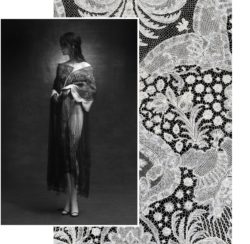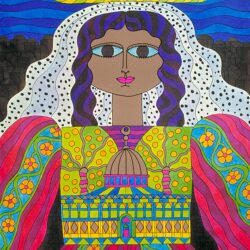P.LACE.S - Looking through Antwerp Lace

The exhibition ‘P.LACE.S - Looking through Antwerp Lace’ highlights the important role the city played in the production and trade of lace. MoMu tells this story through an exhibition trail that connects five locations in the city.
Visitor information
Tickets
Access all simultaneous exhibitions at MoMu with just 1 ticket. To visit the other locations of the P.LACE.S exhibition you need to book a separate ticket and time slot at the respective location. You don't have to visit all locations in one day - the exhibition runs until 9 January 2022.
Description of the exhibition
With ‘P.LACE.S’, MoMu is starting a unique conversation between historical textile craft and contemporary fashion to look at our history from a different perspective. This creates a visual play between past and present, presenting objects from international collections that have never been shown in Belgium before.
Dig deeper
From the mid-16th to the mid-18th centuries, Antwerp played a leading role in the creation and distribution of lace – without linking the city's name to a single type of lace. With an inspired commercial spirit, lace of varying quality was produced and traded for a diverse and international clientele. This ensured that Antwerp adapted to the specific needs of the export countries. The lack of branding – in contrast to Brussels, Bruges or Mechelen, for example – is one of the reasons why studies on lace usually make only passing mention of Antwerp.

Antwerp's different laces in different places
With ‘P.LACE.S’, MoMu highlights the socio-economic and artistic importance of the lace that was long created and traded in Antwerp. By bringing together historical lace, paintings and archival documents from Europe and the US – Flemish lace features prominently in collections from The Metropolitan Museum of Art in New York to the Victoria & Albert Museum in London, the exhibition reveals how, for centuries, Flemish lace was a prominent presence in fashion, interioir design and religion. The role of girls and women in both the production and trade of lace is also given due attention. MoMu presents this rich history in dialogue with contemporary, often high-tech fashion creations that refer to lace in form or concept.
The historical ‘places‘ where the exhibition in Antwerp is taking place have an – often less known – historical link with lace. In the Plantin-Moretus Museum, with one of the oldest archives in the world on the lace trade, and in the Snijders & Rockox House, the exhibition shows exceptional lace and contemporary fashion in historic interiors.
Artistic intervention at two exhibition locations
In addition, SHOWstudio, the acclaimed digital platform of fashion photographer Nick Knight, created an artistic intervention at two exhibition locations at MoMu's request. SHOWstudio made a poetic film for the St Charles Borromeo Church, which boasts the most important collection of lace from the 17th and 18th centuries in Antwerp. At the Maiden's House, where orphaned girls used to learn sewing and lace-making, both substantive and visual parallels were sought between historical and contemporary production techniques. At MoMu the exhibition illustrates the fashionable aspects of lace. Through an overview of different types of clothing and accessories, from shirts to hats, the visitor can explore exactly how lace was worn. Visitors will also discover how today's innovative designers are experimenting with transparency through high-tech 3D printing and laser cutting. This will give them a new perspective on designers and fashion houses such as Iris van Herpen, Azzedine Alaïa, Chanel, Prada and Louis Vuitton, which are using new techniques to explore the conceptual boundaries of lace.

With loans from amongst others: Centraal Museum Utrecht, Chanel, Cooper Hewitt Smithsonian Design Museum, Dior Heritage, Fashion Museum Bath, FelixArchief, Stad Antwerpen, Fondation Azzedine Alaïa, Fries Museum, Gucci, Iris van Herpen, Koninklijk Museum voor Schone Kunsten Antwerpen, Kunstmuseum Den Haag, Louis Vuitton, Manchester Art Gallery, Marios Schwab, Musée de la Visitation, Koninklijke Musea voor Kunst en Geschiedenis, Olivier Theyskens, Onze-Lieve-Vrouwekerk Sint-Truiden, Prada, Rijksmuseum, Simone Rocha, Sint-Gummaruskerk Lier, The Bowes Museum, The Metropolitan Museum of Art, Undercover, V&A…

On the occasion of the exhibition, the book ‘P.LACE.S – Looking through Antwerp Lace’ is published by Lannoo.
Exhibition under the lead of
Research and concept: Frieda Sorber
Curators: Kaat Debo, Wim Mertens, Romy Cockx
Exhibition design: Ania Martchenko
More MoMu exhibitions on view
Besides 'P.LACE.S - Looking through Antwerp Lace', MoMu offers two other exhibition that will be on view during the reopening: 'E/MOTION. Fashion in Transition' and 'Collection presentation - Fashion from the MoMu Collection'









